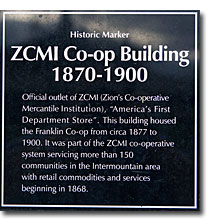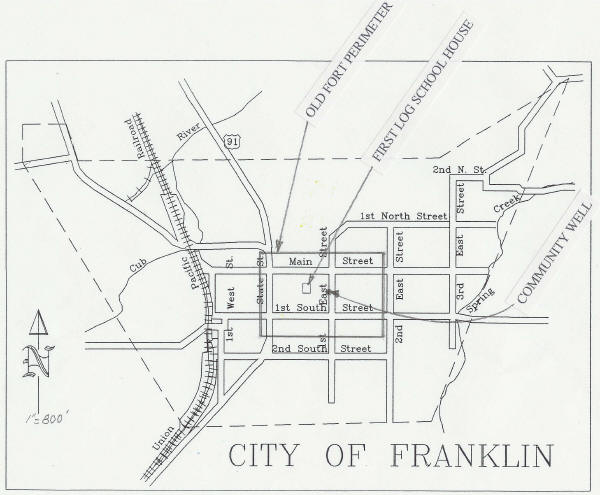|
Journals: Robert Clarkson Ruth Clarkson Ozro Crockett Mary Crockett Websites:
|
Early History of Franklin, Idaho
Information from Gwen N. Gibson, and "History and Development of Franklin, Idaho, during the period 1860-1900" Thesis/Dissertation by James Ira Young at Brigham Young University, 1949.
In April of 1860 families from Provo, Payson, Slaterville, Kayscreek andBountiful left Utah for the area Brigham Young had told them to settle on the "Muddy" now Cub River in the northern part of Cache Valley. It was called Cache Valley because it was a place to cache skins from fur trapping. The whole area was known by Jim Bridger and others as a lush, fertile valley.
They camped first at Camp Cove to explore and on April 14, 1860 after having been joined by many others, they broke camp and 60 families traveled to the current site of Franklin.
Early in May, Apostle Ezra Taft Benson and Peter Maughan came and decided to name the town "Franklin" after Apostle Franklin D. Richards.
The first homes were their wagon boxes with the running gears used for hauling logs from the canyons. They were all grouped together for protection in what they called a fort, from the Indians who were under the command of Chief Kittemere. They got along fairly well with the Indians, though until they were able to build corrals, they did lose horses and cattle to them. In July of that year a resident of Franklin, John Reed Sr. was killed in Smithfield, in retaliation to some prior incident. To avert trouble, the settlers sometimes gave food or cattle to the Indians.
There were no open hostilities until January 1863 when the battle known as the Battle Creek Massacre was fought. This has also been called the Battle of Bear Creek. Prior to that there had been several incidents with miners and people traveling through the valley. These non-Mormons contacted Fort Douglas, near Salt Lake for help. Colonel Conner and 400 U.S. troops came and fought the battle with the Indians at the junction of Battle Creek and Bear River, about twelve miles North of Franklin, also North of Preston. Over 300 men, women and children were killed. Robert Nephi Comish and his brother, John, along with Porter Rockwell and others, watched the Battle Creek Massacre of the Shoshoni Indians by the Federal Troops, and always remembered the horrible event till the day he died.
After the fighting was over, the men of Franklin took teams and sleighs and helped remove the wounded soldiers and indians, and also the Indian women and children. Because of the snow and cold, many had frozen feet. They were all brought to Franklin and cared for until they could be taken elsewhere. The settler felt sorrowful that peace had to come in such a tragic way, for many peaceful Indians had been killed. It did, however, make it possible for the pioneers to move out and begin to take up locations that had been unsafe until then.
When they first arrived they had formed Minute Men, composed of older and married younger men. Each man took his turn standing guard on Little Mountain, west of Franklin, later named Mt. Smart. Robert Nephi was one of the Minute Men. They surveyed city lots of 1/4 acre each, a block containing six acres with eight lots on a block. Every man had a cane lot East of town for sugar cane, later broom corn was also grown East of town. The lay lands know as "New Fields" were South and West of town. Every family was given ten acres. They drew lots the first summer for city lots and also for their ten acres. The first summer they began digging irrigation ditches and canals to bring enough water from the canyons for their fields. It took nearly ten years to complete these, and in the beginning they had only plows and shovels as tools.
In most cases when families were called to move into the wilderness to settle, other family members were given employment on the Salt Lake Temple to make ends meet. Many of the settlers were obliged to walk to Salt Lake, a distance of 110 miles, for their food supplies. Some of those who lived through the first year there said some of the men made as many of four trips there and back, and on the return they had to carry a fifty pound sack of flour. Men and women walked to Salt Lake twice a year for Conference. A whole family might wait days or weeks with nothing but "boiled wheat" and sego roots waiting for the supplies to come.
In 1869 Franklin because incorporated city and it's city boundaries were set. At this time, the survey determined that it was actually in Idaho territory, rather than in Cache County, Utah. This made it the first settled town in Idaho.
 In 1871 Brigham Young had machinery shipped from the east for a steam sawmill. John Biggs ran it for years. It sawed 300,000 board feet for Z.C.M.I. in Salt Lake, and used for railroad ties when the railroad was extended to Franklin. After it was used by others in Franklin Basin until 1900, now in Relic Hall in Franklin. That hall began it's life as Franklin's Cooperative Mercantile Industry in 1869. Later it was consolidated with the Woolen Mills. Clothing, blankets, bedding, rugs and carpets were made from their own raw materials. They raised sheep for wool, and flax for linens, their own dyes for color. Thomas Hull and Peter Lowe were master weavers from Scotland, and they build the first loom.
In 1871 Brigham Young had machinery shipped from the east for a steam sawmill. John Biggs ran it for years. It sawed 300,000 board feet for Z.C.M.I. in Salt Lake, and used for railroad ties when the railroad was extended to Franklin. After it was used by others in Franklin Basin until 1900, now in Relic Hall in Franklin. That hall began it's life as Franklin's Cooperative Mercantile Industry in 1869. Later it was consolidated with the Woolen Mills. Clothing, blankets, bedding, rugs and carpets were made from their own raw materials. They raised sheep for wool, and flax for linens, their own dyes for color. Thomas Hull and Peter Lowe were master weavers from Scotland, and they build the first loom.
In 1868 the telegraph was connected to Franklin, and in 1876, the first complete report of the Custer Massacre in the Little Big Horn was sent to the government from Franklin. Riders came from Montana with the news.
In 1874 most of the inhabitants of Franklin decided to establish and live the United Order. John Biggs was the Vice President.
Many men were jailed for polygamy, even as far away as California. Most of this trouble was in 1885-7, when John Biggs was away on a mission.
For a while Franklin was a business Center of the North, but the eventual result of the railroad reaching Pocatello, was that Franklin lost the commercial importance it once had, but by the middle of the twentieth century it was main mink raising center and also an egg producing center, as well as noted for its dairy industry.
Today, it is a quiet rural town, but the Relic Hall holds a lot of the history of the early days including a model of the fort, and photographs of many of the early settlers.

| If you see any problems with this website, feel free to contact our Webmaster. |